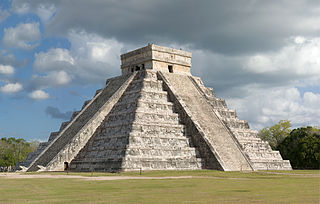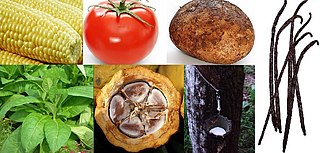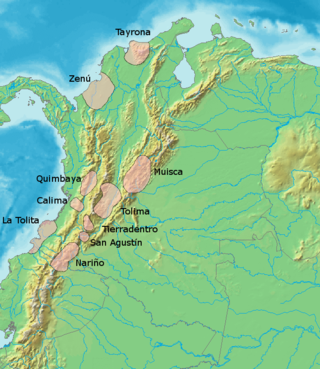See also
-
 The dictionary definition of relict at Wiktionary
The dictionary definition of relict at Wiktionary - Endemism
- Hysteresis
- Living fossil
- Refugium (population biology)
- Relic
- Palaeochannel
A relict is a surviving remnant of a natural phenomenon.
A relict (or relic) is an organism that at an earlier time was abundant in a large area but now occurs at only one or a few small areas.
In geology, a relict is a structure or mineral from a parent rock that did not undergo metamorphosis when the surrounding rock did, or a rock that survived a destructive geologic process.
In geomorphology, a relict landform is a landform formed by either erosive or constructive surficial processes that are no longer active as they were in the past.
A glacial relict is a cold-adapted organism that is a remnant of a larger distribution that existed in the ice ages.
As revealed by DNA testing, a relict population is an ancient people in an area, who have been largely supplanted by a later group of migrants and their descendants.
In various places around the world, minority ethnic groups represent lineages of ancient human migrations in places now occupied by more populous ethnic groups, whose ancestors arrived later. For example, the first human groups to inhabit the Caribbean islands were hunter-gatherer tribes from South and Central America. Genetic testing of natives of Cuba show that, in late pre-Columbian times, the island was home to agriculturalists of Taino ethnicity. In addition, a relict population of the original hunter-gatherers remained in western Cuba as the Ciboney people. [1]

The history of the Americas begins with people migrating to these areas from Asia during the height of an ice age. These groups are generally believed to have been isolated from the people of the "Old World" until the coming of Europeans in the 10th century from Iceland led by Leif Erikson, and in 1492 with the voyages of Christopher Columbus.

The Proto-Indo-Europeans are a hypothetical prehistoric ethnolinguistic group of Eurasia who spoke Proto-Indo-European (PIE), the reconstructed common ancestor of the Indo-European language family.

In the history of the Americas, the pre-Columbian era spans from the original settlement of North and South America in the Upper Paleolithic period through European colonization, which began with Christopher Columbus's voyage of 1492. Usually, the era covers the history of Indigenous cultures until significant influence by Europeans. This may have occurred decades or even centuries after Columbus for certain cultures.
The Lucayan people were the original residents of The Bahamas before the European conquest of the Americas. They were a branch of the Taínos who inhabited most of the Caribbean islands at the time. The Lucayans were the first indigenous Americans encountered by Christopher Columbus. Shortly after contact, the Spanish kidnapped and enslaved Lucayans, with the displacement culminating in the complete eradication of the Lucayan people from the Bahamas by 1520.

The Columbian exchange, also known as the Columbian interchange, was the widespread transfer of plants, animals, precious metals, commodities, culture, human populations, technology, diseases, and ideas between the New World in the Western Hemisphere, and the Old World (Afro-Eurasia) in the Eastern Hemisphere, in the late 15th and following centuries. It is named after the Italian explorer Christopher Columbus and is related to the European colonization and global trade following his 1492 voyage. Some of the exchanges were purposeful; some were accidental or unintended. Communicable diseases of Old World origin resulted in an 80 to 95 percent reduction in the number of Indigenous peoples of the Americas from the 15th century onwards, most severely in the Caribbean. The cultures of both hemispheres were significantly impacted by the migration of people from the Old World to the New. European colonists and African slaves replaced Indigenous populations across the Americas, to varying degrees. The number of Africans taken to the New World was far greater than the number of Europeans moving to the New World in the first three centuries after Columbus.

The Ciboney, or Siboney, were a Taíno people of central Cuba, Jamaica, and the Tiburon Peninsula of Haiti. A Western Taíno group living in central Cuba during the 15th and 16th centuries, they had a dialect and culture distinct from the Classic Taíno in the eastern part of the island, though much of the Ciboney territory was under the control of the eastern chiefs. Confusion in the historical sources led 20th-century scholars to apply the name "Ciboney" to the non-Taíno Guanahatabey of western Cuba and various archaic cultures around the Caribbean, but this is deprecated.

Coulee, or coulée is a term applied rather loosely to different landforms, all of which refer to a kind of valley or drainage zone. The word coulee comes from the Canadian French coulée, from French couler 'to flow'.

The Guanahatabey were an indigenous people of western Cuba at the time of European contact. Archaeological and historical studies suggest the Guanahatabey were archaic hunter-gatherers with a distinct language and culture from their neighbors, the Taíno. They might have been a relic of an earlier culture that spread widely through the Caribbean before the ascendance of the agriculturalist Taíno.

In the classification of archaeological cultures of North America, the Woodland period of North American pre-Columbian cultures spanned a period from roughly 1000 BCE to European contact in the eastern part of North America, with some archaeologists distinguishing the Mississippian period, from 1000 CE to European contact as a separate period. The term "Woodland Period" was introduced in the 1930s as a generic term for prehistoric sites falling between the Archaic hunter-gatherers and the agriculturalist Mississippian cultures. The Eastern Woodlands cultural region covers what is now eastern Canada south of the Subarctic region, the Eastern United States, along to the Gulf of Mexico.

The Indigenous peoples of the Americas are the inhabitants of the Americas before European colonization in the 15th century, and the ethnic groups who now identify themselves with those peoples. They are a diverse group of peoples, with a wide range of cultures, languages, and ways of life.
The Maritime Archaic is a North American cultural complex of the Late Archaic along the coast of Newfoundland, the Canadian Maritimes and northern New England. The Maritime Archaic began in approximately 7000 BC and lasted until approximately 3500 BC, corresponding with the arrival of the Paleo-Eskimo groups who may have outcompeted the Maritime Archaic for resources. The culture consisted of sea-mammal hunters in the subarctic who used wooden boats. Maritime Archaic sites have been found as far south as Maine and as far north as Labrador. Their settlements included longhouses, and boat-topped temporary or seasonal houses. They engaged in long-distance trade, as shown by white chert from northern Labrador being found as far south as Maine.
At the time of first contact between Europe and the Americas, the indigenous peoples of the Caribbean included the Taíno of the northern Lesser Antilles, most of the Greater Antilles and the Bahamas, the Kalinago of the Lesser Antilles, the Ciguayo and Macorix of parts of Hispaniola, and the Guanahatabey of western Cuba. The Kalinago have maintained an identity as an indigenous people, with a reserved territory in Dominica.

The Caribbean is a subregion of the Americas that includes the Caribbean Sea and its islands, some of which are surrounded by the Caribbean Sea and some of which border both the Caribbean Sea and the North Atlantic Ocean; the nearby coastal areas on the mainland are often also included in the region. The region is southeast of the Gulf of Mexico and the North American mainland, east of Central America, and north of South America.

Taíno is an extinct Arawakan language that was spoken by the Taíno people of the Caribbean. At the time of Spanish contact, it was the most common language throughout the Caribbean. Classic Taíno was the native language of the Taíno tribes living in the northern Lesser Antilles, Puerto Rico, the Turks and Caicos Islands, and most of Hispaniola, and expanding into Cuba. The Ciboney dialect is essentially unattested, but colonial sources suggest it was very similar to Classic Taíno, and was spoken in the westernmost areas of Hispaniola, the Bahamas, Jamaica, and most of Cuba.

The Taíno were a historic Indigenous people of the Caribbean, whose culture has been continued today by Taíno descendant communities and Taíno revivalist communities. At the time of European contact in the late 15th century, they were the principal inhabitants of most of what is now Cuba, the Dominican Republic, Jamaica, Haiti, Puerto Rico, the Bahamas, and the northern Lesser Antilles. The Lucayan branch of the Taíno were the first New World peoples encountered by Christopher Columbus, in the Bahama Archipelago on October 12, 1492. The Taíno spoke a dialect of the Arawakan language group. They lived in agricultural societies ruled by caciques with fixed settlements and a matrilineal system of kinship and inheritance. Taíno religion centered on the worship of zemis.

The African Pygmies are a group of ethnicities native to Central Africa, mostly the Congo Basin, traditionally subsisting on a forager and hunter-gatherer lifestyle. They are divided into three roughly geographic groups:
In biogeography and paleontology, a relict is a population or taxon of organisms that was more widespread or more diverse in the past. A relictual population is a population currently inhabiting a restricted area whose range was far wider during a previous geologic epoch. Similarly, a relictual taxon is a taxon which is the sole surviving representative of a formerly diverse group.

Guanahatabey (Guanajatabey) was the language of the Guanahatabey people, a hunter-gatherer society that lived in western Cuba until the 16th century. Very little is known of it, as the Guanahatabey died off early in the period of Spanish colonization before substantial information about them was recorded. Evidence suggests it was distinct from the Taíno language spoken in the rest of the island.

The pre-Columbian cultures of Colombia refers to the ancient cultures and civilizations that inhabited Colombia before the Spanish Conquest in the 16th century.
{{citation}}: CS1 maint: multiple names: authors list (link)